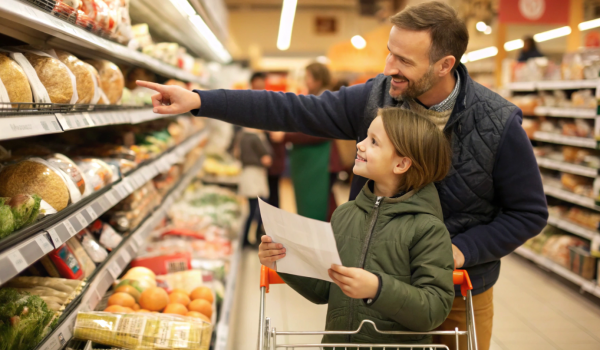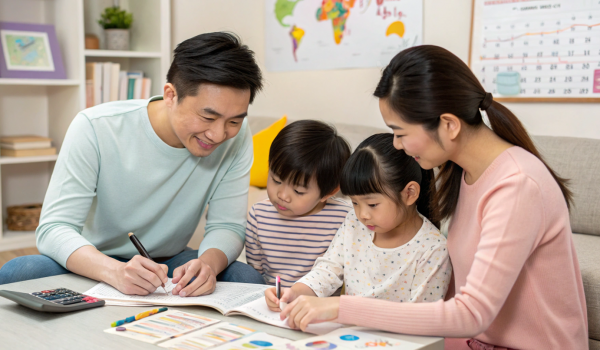Picture this: It’s a sunny Saturday morning. The smell of fresh pancakes fills the kitchen. Eight-year-old Maya sits at the table, swinging her legs under the chair, waiting for breakfast. Her mom, pouring syrup into a little pitcher, mutters something under her breath about “taxes” as she pays a bill from her phone. Maya, curious as always, asks:
“Why do we have to give money away?”
It’s a small, innocent question, but it’s the kind of question that reveals something big — kids notice money, they notice how we react to it, and they especially notice when it leaves our hands. If we don’t give them a clear answer, they’ll invent one. And when it comes to taxes, the answers they make up can be wildly wrong:
-
“The government just takes it for themselves.”
-
“It’s a punishment for making money.”
-
“It’s just something annoying grown-ups have to deal with.”
The truth? Taxes aren’t punishment. They aren’t mysterious. And they aren’t just for “grown-up stuff” kids will never care about. Taxes are one of the ways we work together to keep our communities running — and if we can teach kids to see them that way, we can replace resentment with responsibility.
This guide will help you explain taxes to your kids in a way they’ll understand — and even care about. You’ll get a short script you can use in everyday moments, real-life examples that stick, and fun activities to make taxes a hands-on lesson rather than a boring lecture. Think of it as giving your child a map so they can navigate a system they’ll be part of for the rest of their lives.
The Story That Matters: From “Why” to “How”
Donald Miller talks about storytelling as the art of helping someone see themselves as the hero in a story — and that’s exactly what you’re doing when you explain taxes to your kids.
In this story:
-
The Hero: Your child
-
The Problem: Taxes seem confusing or unfair
-
The Guide: You, the parent, explaining in simple terms
-
The Plan: Show them why we pay taxes, where the money goes, and how they’ll be part of it one day
-
The Transformation: They move from confusion to understanding, from feeling like money is “taken” to knowing it’s “shared” for things we all need
Here’s the core sentence you want to pass along — one line your child can carry with them:
“Taxes are the price we pay for things we all use — like schools, roads, and firefighters. They’re how we share the responsibility of taking care of our community.”
This one sentence is the anchor. You can build on it, but always come back to it when they seem confused.
Start with a Short, True Story (2 Minutes)
Children remember stories far better than abstract ideas. And when it comes to something as big as taxes, stories shrink the idea down to a size they can hold in their hands.
Here’s one you can use:
“When I was your age, there was a playground near our house. One year the swings broke. The town fixed them, but they needed money to pay for the new swings. Everybody in the town paid a little bit of money over time so the park could be fixed. Taxes are like that — small bits from many people to pay for things everyone uses.”
Notice this story is short, personal, and relatable. There’s no jargon, no politics, and no finger-pointing — just a clear cause-and-effect kids can visualize.
Use Three Plain Examples Kids Understand
Abstract concepts are like helium balloons — they float away if you don’t tie them to something concrete. So, when you explain taxes, tie them to three things your kids already use and enjoy.
1. Things We Use Every Day (Public Goods)
Parks, schools, libraries, playgrounds, sidewalks, streetlights — these are things kids see and use regularly. You can point to them on the drive to school or during a walk.
Example conversation:
“See that crosswalk with the blinking lights? Taxes paid for that so cars stop and kids can cross safely. Without taxes, we’d all have to chip in separately or hope someone would volunteer to buy it.”
Public goods like these are funded by taxes because they benefit everyone and no one can be excluded from using them. Learn more about public goods at Investopedia’s Public Goods Definition.
2. People Who Help Us (Services)
Firefighters, police officers, public school teachers, and sanitation workers are paid through tax money.
Example conversation:
“Remember the time the fire truck came to your school to talk about fire safety? That truck, the gear, and the firefighters’ salaries are all paid for with tax money — so they’re ready to help anyone in an emergency.”
These essential services are supported by taxes so communities stay safe and healthy. You can explore more about government services funded by taxes at USA.gov – How Government Works.
3. Rules and Safety (Infrastructure & Systems)
Roads, bridges, sewer systems, and even public health programs fall under this category.
Example conversation:
“When we drive on smooth roads without big holes, it’s because tax money was used to fill them. If we didn’t have taxes, we’d all be driving on bumpy, unsafe roads unless we paid for repairs ourselves.”
Infrastructure is expensive and benefits everyone, so taxes pay for it collectively. Read more about how taxes fund infrastructure at IRS – Understanding Taxes.
By breaking it into these three categories, you help kids see that taxes aren’t just some vague number on a paycheck — they’re connected to things they touch, see, and benefit from every single day.
Simple Definitions — Three Phrases That Won’t Bore Them
When explaining taxes to kids, less is more. They don’t need a 20-minute history lesson — they need a few “sticky” definitions they can repeat back to you.
-
Tax: Money people and businesses give to the government so it can pay for things everyone uses.
-
Income tax: Money taken from paychecks to fund public services.
-
Sales tax: A little extra fee added when you buy something, which helps pay for local services.
Have them repeat these definitions. The repetition helps the terms stick, so the next time they hear “sales tax” at the store, it clicks.
You can find kid-friendly explanations of taxes at the IRS Tax Tips for Kids.
Explain Where Taxes Come From and Where They Go
To make taxes real, show the flow of money.
Grab three jars and some coins:
-
Jar 1: Income Tax – Drop in coins to represent money taken from a paycheck. Say: “This pays for schools, roads, and national programs.”
-
Jar 2: Sales Tax – Drop coins in whenever you pretend to “buy” something. Say: “This helps the city pay for police, firefighters, and parks.”
-
Jar 3: Property Tax – If you own a home, explain how part of what you pay goes to the local community, especially schools.
Then explain where the money goes:
-
Education
-
Safety
-
Health
-
Infrastructure
-
Community programs
Using physical coins makes it far more tangible for kids than simply talking about it.
For more details on types of taxes, see Investopedia – Types of Taxes.
Talk About Fairness — and What It Actually Looks Like
Kids have a built-in fairness radar, and taxes are a perfect place to help them understand shared responsibility.
Explain it like this:
“People who earn more money often pay more in taxes. That way, we can help make sure things like schools and hospitals are available to everyone. It’s like when you and your friends share snacks — if you have a big bag and they only have a little, you share more so everyone gets some.”
You can also talk about different systems:
-
Progressive tax: People with higher incomes pay a higher percentage.
-
Flat tax: Everyone pays the same percentage.
Let them talk about what they think is fair. This builds critical thinking skills without turning it into a political argument.
Learn more about tax fairness and structures at Tax Foundation – Types of Taxes.
Practical Mini-Lessons You Can Do Together
Here are three simple activities that turn tax talk into something hands-on:
1. The Paycheck Game (Ages 8+)
Print or draw a mock paycheck showing gross pay. Subtract “taxes” for things like schools, parks, and roads. Show them the difference between gross pay and take-home pay. Ask: “If you had this money, what would you spend? Save? Share?”
2. Sales Tax Shop (Ages 6–12)
Set up a pretend store in your living room. Price an item at $10, then add a “sales tax” of $0.80. Let them hand over $10 and explain why they owe a little more at the “checkout.”
3. The Community Vote (Ages 7+)
Give your child 10 “tax tokens” and three “projects” to choose from — maybe a new basketball hoop, library books, or a park cleanup day. Let them decide how to allocate the tokens. Then discuss why they made their choices.
These interactive lessons help your child see taxes as part of daily life and decision-making.
Be Honest About the Gray Areas
Taxes aren’t perfect — and kids will sense that if you pretend otherwise.
You can say:
“Sometimes tax money isn’t used as wisely as it could be. Just like in a family budget, sometimes money gets spent on the wrong things. That’s why we have rules, audits, and voting — so we can try to make sure the money is used well.”
This honesty keeps you credible, and it teaches kids that being an informed citizen means asking questions and paying attention.
How This Helps Them Later
Teaching kids about taxes now plants seeds for:
-
Civic literacy — They’ll understand how governments work and be better voters later.
-
Financial literacy — They’ll grasp net vs. gross pay before their first job.
-
Critical thinking — They’ll learn to ask “Where does the money go?” before spending or voting.
In other words, you’re not just teaching them about taxes — you’re teaching them how to think about money and community.
Final Scene: Inviting Them Into the Story
Return to our Saturday morning scene.
“Maya, remember the swings that broke? Today we paid sales tax when we bought lunch. Some of that money helps fix things like parks. Next time, you can help me choose what part of the community we’d want to support most.”
Give them one small, concrete way to participate. It might be spotting a sales tax line on a receipt or voting on where to “spend” a family donation. Those little moments build lifelong understanding.
Bottom line: Taxes aren’t just about numbers on a paycheck. They’re about how we live together, share responsibility, and take care of the places and people around us. If you can help your kids see that, you’re not just teaching them about money — you’re giving them a sense of ownership in their own community’s story.




